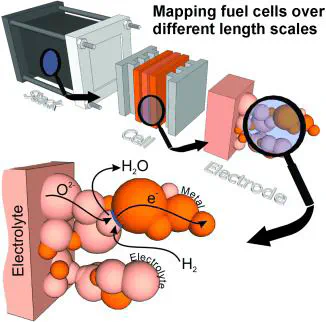What happens inside a fuel cell? Developing an experimental functional map of fuel cell performance
Aug 20, 2010·
,
,
,
,
,
,
,
,
,
 ,
,
,
,
,
·
0 min read
,
,
,
,
,
·
0 min read
D. J. L. Brett
A. R. Kucernak
P. Aguiar
S. C. Atkins
N. P. Brandon
R. Clague
L. F. Cohen
G. Hinds
C. Kalyvas
G. J. Offer
Prof. Dr. Bradley P. Ladewig
R. Maher
A. Marquis
P. Shearing
N. Vasileiadis
V. Vesovic

Abstract
Fuel cell performance is determined by the complex interplay of mass transport, energy transfer and electrochemical processes. The convolution of these processes leads to spatial heterogeneity in the way that fuel cells perform, particularly due to reactant consumption, water management and the design of fluid-flow plates. It is therefore unlikely that any bulk measurement made on a fuel cell will accurately represent performance at all parts of the cell. The ability to make spatially resolved measurements in a fuel cell provides one of the most useful ways in which to monitor and optimise performance. This Minireview explores a range of in situ techniques being used to study fuel cells and describes the use of novel experimental techniques that the authors have used to develop an ‘experimental functional map’ of fuel cell performance. These techniques include the mapping of current density, electrochemical impedance, electrolyte conductivity, contact resistance and CO poisoning distribution within working PEFCs, as well as mapping the flow of reactant in gas channels using laser Doppler anemometry (LDA). For the high-temperature solid oxide fuel cell (SOFC), temperature mapping, reference electrode placement and the use of Raman spectroscopy are described along with methods to map the microstructural features of electrodes. The combination of these techniques, applied across a range of fuel cell operating conditions, allows a unique picture of the internal workings of fuel cells to be obtained and have been used to validate both numerical and analytical models.
Type
Publication
ChemPhysChem